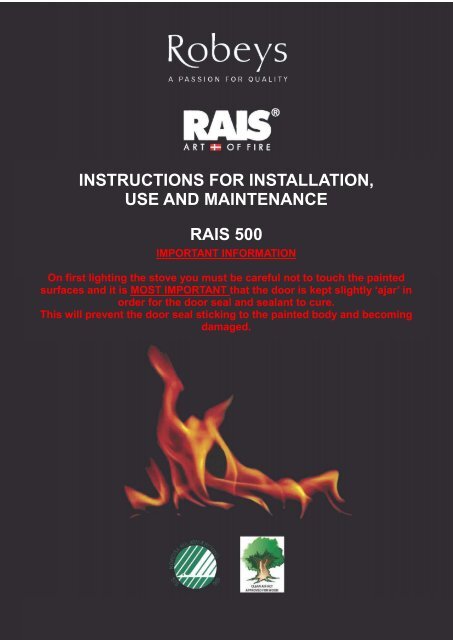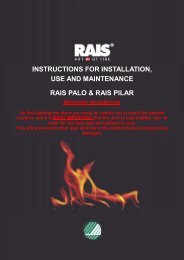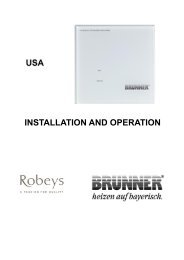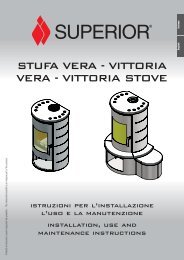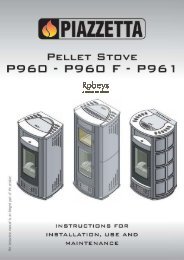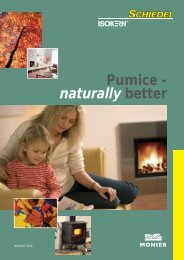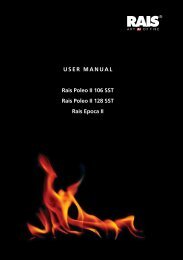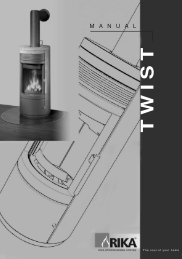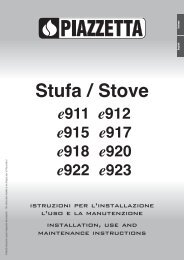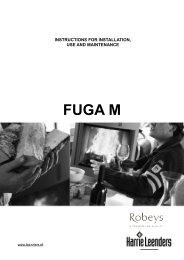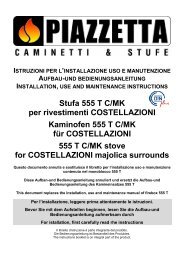Rais 500 Installation, Use and Maintenance Manual - Robeys Ltd
Rais 500 Installation, Use and Maintenance Manual - Robeys Ltd
Rais 500 Installation, Use and Maintenance Manual - Robeys Ltd
Create successful ePaper yourself
Turn your PDF publications into a flip-book with our unique Google optimized e-Paper software.
ENGLISH RAIS - manual for <strong>Rais</strong> <strong>500</strong>2
ENGLISH RAIS - manual for <strong>Rais</strong> <strong>500</strong>INSTALLATION INSTRUCTIONSThe following pages give instructions for the safe <strong>and</strong> proper installation of this heatingappliance in the UK. These instructions cover the basic principles of installation,although some details may need slight modification to suit particular local site conditions.In all cases the installation must comply with current UK Building Regulations, LocalAuthority Byelaws <strong>and</strong> other specifications or regulations as they affect the installation ofthe stove.Please note that it is a legal requirement under Engl<strong>and</strong> <strong>and</strong> Wales Building Regulationsthat the installation of the stove is either carried out under local Authority BuildingControl approval or is installed by a Competent Person registered with a Governmentapproved Competent Persons Scheme. HETAS operate such a scheme <strong>and</strong> a listing oftheir registered Competent Persons can be found on their website at www.hetas.co.uk.It should be noted that the current Building Regulations requirements are given inApproved Document J. These requirements may also be met by adopting the relevantrecommendations given in British St<strong>and</strong>ards BS 8303, BS EN15287-1:2007.WARNING. Health <strong>and</strong> Safety Advice Notice.The installation of this heating appliance is governed by the Health <strong>and</strong> Safety at WorkAct 1974. it is the responsibility of the installer to ensure that all requirements of this Actare met during the installation works. Attention is drawn in particular to the following:H<strong>and</strong>ling:The appliance is a heavy item <strong>and</strong> adequate facilities must be availablefor loading, unloading <strong>and</strong> site h<strong>and</strong>ling.Fire Cement: Some types of fire cement are caustic <strong>and</strong> should not be allowed to comeinto contact with the skin. Protective gloves should be worn whenh<strong>and</strong>ling fire cement. In case of contact with the skin, wash immediatelywith plenty of water.Asbestos:Metal Parts:This stove contains no asbestos. If there is a possibility of disturbing anyasbestos in the course of the installation, then please seek specialistguidance <strong>and</strong> use appropriate protective equipment.When installing or servicing this stove care should be taken to avoid thepossibility of personal injury.Important Warning - Preparatory Work <strong>and</strong> safety Checks:• This stove must not be installed into a chimney which serves any other heatingappliance.• There must not be an extractor fan fitted in the same room as the stove, as this cancause the stove to emit fumes into the room.• If this appliance is installed into an existing chimney, the chimney must first beswept <strong>and</strong> examined for soundness <strong>and</strong> suitability, before the appliance is installed(see also section headed ‘Chimney’).6
ENGLISH RAIS - manual for <strong>Rais</strong> <strong>500</strong>Convection<strong>Rais</strong> stoves are convection stoves. This means that the stove’s back <strong>and</strong> side panels arenot over-heated. Convection means that there is a circulation of air, which ensures thatthe heat is distributed more evenly throughout the entire room. The cold air is sucked in atthe base of the stove <strong>and</strong> up through the convection channel, which runs along thestove’s combustion chamber. The heated air comes out at the top of the stove, whichensures a circulation of warm air throughout the room.The stoves are equipped with cool door h<strong>and</strong>les - a <strong>Rais</strong> special feature - which meansyou could almost do away with gloves. Be aware, however, that all exterior surfacesbecome hot during use - so take extreme care.ChimneyIn order for the stove to perform satisfactorily the chimney height must be sufficient toensure an adequate draught of approximately 15 Pa so as to clear the products ofcombustion <strong>and</strong> prevent smoke problems into the room.NOTE: A chimney height of not less than 4.5 metres measured vertically from the outlet ofthe stove to the top of the chimney should be satisfactory. Alternatively the calculationprocedure given in EN 13384-1 may be used as the basis for deciding whether aparticular chimney design will provide sufficient draught.Please Note, this appliance has been tested by the manufacturers <strong>and</strong> works on a 3mstraight flue.The outlet from the chimney should be above the roof of the building in accordance withthe provisions of Building Regulations Approved Document J.If installation is into an existing chimney then it must be sound <strong>and</strong> have no cracks orother faults which might allow fumes into the house. Older properties, especially, mayhave chimney faults or the cross section may be too large i.e. more than 230 mm x 230mm. Remedial action should be taken, if required, seeking expert advice, if necessary. If itis found necessary to line the chimney then a flue liner suitable for solid fuel must be usedin accordance with Building Regulations Approved Document J.Any existing chimney must be clear of obstruction <strong>and</strong> have been swept cleanimmediately before installation of the stove. If the stove is fitted in place of an open firethen the chimney should be swept one month after installation to clear any soot fallswhich may have occurred due to the difference in combustion between the stove <strong>and</strong> theopen fire.If there is no existing chimney then any new system must be to the designationdescribed above <strong>and</strong> in accordance with Building Regulations Approved Document J.A single wall metal fluepipe is suitable for connecting the stove to the chimney but is notsuitable for use as the complete chimney. The chimney <strong>and</strong> connecting fluepipe musthave a minimum diameter of 150 mm <strong>and</strong> its dimension should be not less than the sizeof the outlet socket of the stove.7
ENGLISH RAIS - manual for <strong>Rais</strong> <strong>500</strong>Any bend in the chimney or connecting fluepipe should not exceed 45°.90° bends should not be used.Combustible material should not be located where the heat dissipating through thewalls of fireplaces or flues could ignite it. Therefore when installing the stove in thepresence of combustible materials due account must be taken of the guidance on theseparation of combustible material given in Building Regulations Approved DocumentJ <strong>and</strong> also in these stove instructions.If it is found that there is excessive draught in the chimney then a draught stabilisershould be fitted. Fitting of a draught stabiliser will affect the requirement for thepermanent air supply into the room in which the stove is fitted in accordance withApproved Document J (see also combustion air supply).Adequate provision e.g. easily accessible soot door or doors must be provided forsweeping the chimney <strong>and</strong> connecting fluepipe where it is not intended for thechimney to be swept through the appliance.Chimney FiresIf the chimney is thoroughly <strong>and</strong> regularly swept, chimney fires should not occur.However, if a chimney fire does occur turn off the stove immediately <strong>and</strong> isolate themains electricity supply (if applicable), <strong>and</strong> tightly close the doors of the stove. Thisshould cause the chimney fire to go out. If the chimney fire does not go out when theabove action is taken then the fire brigade should be called immediately. Do not relightthe stove until the chimney <strong>and</strong> flue ways have been cleaned <strong>and</strong> examined by aprofessional.8
ENGLISH RAIS - manual for <strong>Rais</strong> <strong>500</strong>Ventilation - make the best possible use of the inserts.The stove is equipped with four convection air outlets, which can be connected withsuitable air ducts to other rooms.Note, this is NOT a working drawing.10
ENGLISH RAIS - manual for <strong>Rais</strong> <strong>500</strong>Combustion air supplyIn order for the stove to perform efficiently <strong>and</strong> safely there must be an adequate airsupply into the room in which the stove is installed to provide combustion air. Theprovision of air supply to the stove must be in accordance with current BuildingRegulations Approved Document J. An opening window is not appropriate for thispurpose.<strong>Installation</strong>It is prohibited to carry out unauthorised alterations to the stove.There must be plenty of fresh air in the room where the stove is being installed, in order toensure proper combustion. Note that any mechanical exhaust ventilation - e.g. anextraction hood - is not permitted. Any air grilles must be placed in such a manner, thatthe air supply is not blocked.The stove is equipped with four convection air outlets, which may be connected withsuit-able air ducts to other rooms.Building Regulations Approved Document J gives specific guidance on the requiredpermanent ventilation into the room for combustion air of solid fuel appliances.The floor structure must be able to carry the weight of the wood burning stove, as well asthe weight of a chimney, if necessary.When you choose where to set up your RAIS wood burning stove, you should consider theheat distribution to the other rooms. This will enable you to get the best use out of yourstove.The stove should be set up at a safe distance from inflammable materials.See the manufacturer's plate on the wood burning stove.<strong>Installation</strong> of stove:NOTE !A decision must be made concerning the positioning of the inlets <strong>and</strong> outlets ofthe convection system. Discolouration of the wall above the doors <strong>and</strong> theconvection air outlets may occur due to convected hot air.RAIS cannot take responsibility for any building work or consequential damage.The stove should be inspected for defects at receipt.11
ENGLISH RAIS - manual for <strong>Rais</strong> <strong>500</strong>Lift the stove from the pallet to the place of installation on to a suitably protected floor.The stove can be mounted on the optional adjustable st<strong>and</strong> ( see page 29 ).These are available to order from your local <strong>Rais</strong> dealer / stockist.Using a spirit level against the door <strong>and</strong> body of the stove, ensure that the stove isperfectly level <strong>and</strong> make adjustments using the levelling bolts in the base.Remove the frame <strong>and</strong> door from the stove. Be careful not to damage the glass orpaint.Seal the flue pipe on to the flue outlet using fire cement <strong>and</strong> self tapping screws <strong>and</strong>connect to the chimney.Connect the convection air ducts, if required.Install air system manifold kit ( A ) to the pipe stub, if required ( optional ).The stove is now ready to be built in using either stud walls or solid walls.When the walls have been finished <strong>and</strong> decorated, the frame <strong>and</strong> door can bere-fitted. Remove all protective plastic <strong>and</strong> tape prior to commissioning.AA12
ENGLISH RAIS - manual for <strong>Rais</strong> <strong>500</strong>Insulation ability such as Aqua panel ( coefficient of thermal conductivity 0.36 W/mk )or better. Please use metal stud.Insulate ceiling ifnecessary13
ENGLISH RAIS - manual for <strong>Rais</strong> <strong>500</strong>Insulate ceiling ifnecessary14
ENGLISH RAIS - manual for <strong>Rais</strong> <strong>500</strong>Insulate ceiling ifnecessaryDistance to noncombustible material50mm minDistance to noncombustible material50mm min15
ENGLISH RAIS - manual for <strong>Rais</strong> <strong>500</strong>16
ENGLISH RAIS - manual for <strong>Rais</strong> <strong>500</strong>17
ENGLISH RAIS - manual for <strong>Rais</strong> <strong>500</strong><strong>Installation</strong> distance in case of combustible wallTo find out whether the wall next to where the stove is going to be installed is flammable,you should contact your building contractor or the local building authorities.The hearth should be able to accommodate the weight of the stove. The chimney mustbe independently supported by wall brackets or a ceiling support plate. The weight of thestove is indicated in the brochure.The stove should always be installed on a non-combustible hearth of a size <strong>and</strong>construction that is in accordance with the provisions of the current UK BuildingRegulations Approved Document J.If the stove is to be installed on a wooden floor, it must be covered with anon-combustible material at least 12mm thick, in accordance with UK BuildingRegulations Approved Document J, to a distance of 300 mm in front of the stove <strong>and</strong>150 mm to each side measuring from the door of the combustion chamber.The clearance distances to combustible material beneath, surrounding or upon thehearth <strong>and</strong> walls adjacent to the hearth should comply with the guidance on theseparation of combustible material given in UK Building Regulations ApprovedDocument J <strong>and</strong> also in these stove instructions.Commissioning <strong>and</strong> h<strong>and</strong>overEnsure all parts are fitted in accordance with the instructions.On completion of the installation allow a suitable period of time for any fire cement <strong>and</strong>mortar to dry out, before lighting the stove. Once the stove is under fire check all sealsfor soundness <strong>and</strong> check that the flue is functioning correctly <strong>and</strong> that all products ofcombustion are vented safely to atmosphere via the chimney terminal.On completion of the installation <strong>and</strong> commissioning ensure that the operatinginstructions for the stove are left with the customer. Ensure to advise the customer onthe correct use of the appliance <strong>and</strong> warn them to use only the recommended fuel for thestove.Advise the user what to do should smoke or fumes be emitted from the stove. Thecustomer should be warned to use a fireguard to BS 8423:2002 (Replaces BS 6539) inthe presence of children, aged <strong>and</strong>/or infirm persons.CO AlarmBuilding regulations require that when ever a new or replacement fixed solid fuel orwood/biomass appliance is installed in a dwelling a carbon monoxide alarm must befitted in the same room as the appliance. Further guidance on the installation of thecarbon monoxide alarm is available in BS EN 50292:2002 <strong>and</strong> from the alarmmanufacturer’s instructions.Provision of an alarm must not be considered a substitute for either installing theappliance correctly or ensuring regular servicing <strong>and</strong> maintenance of the appliance <strong>and</strong>chimney system.18
ENGLISH RAIS - manual for <strong>Rais</strong> <strong>500</strong>19
ENGLISH RAIS - manual for <strong>Rais</strong> <strong>500</strong>20
ENGLISH RAIS - manual for <strong>Rais</strong> <strong>500</strong>21
ENGLISH RAIS - manual for <strong>Rais</strong> <strong>500</strong>22
ENGLISH RAIS - manual for <strong>Rais</strong> <strong>500</strong>23
ENGLISH RAIS - manual for <strong>Rais</strong> <strong>500</strong>24
ENGLISH RAIS - manual for <strong>Rais</strong> <strong>500</strong>MAINTENANCECleaning <strong>and</strong> careThe wood burning stove <strong>and</strong> the chimney must be serviced by a chimney sweep twice ayear.During cleaning <strong>and</strong> care, the stove must be cold.If the glass is sooty:- Moisten a piece of paper or newspaper, dip it in the ash, <strong>and</strong> rub the sooty glass with it.- Now rub with a dry piece of paper <strong>and</strong> the glass will become clean.- As an alternative you can use glass cleaner, which you can buy from you RAISdistributor.Clean the exterior with a dry sponge or a soft brush.Cleaning the combustion chamber:Scrape/shovel the ash out <strong>and</strong> store it in a non-flammable container until it has cooleddown. You can dispose of ash with your normal household waste or recycle on thegarden.REMEMBER!!Never remove all the ashes from the combustion chamber - the wood will burn at its bestwith a layer of ashes of approx. 20 mm.Prolonged periods of non-use:If the stove is to be left unused for a prolonged period of time then it should be given athorough clean to remove ash <strong>and</strong> unburned fuel residues. To enable a good flow of airthrough the appliance to reduce condensation <strong>and</strong> subsequent damage, leave the aircontrols fully open.Prior to a new heating season, it should be checked that the chimney <strong>and</strong> flue pipeconnector are not blocked.Chimney cleaningThe chimney should be swept at least twice a year. It is important that the flue connection<strong>and</strong> chimney are swept prior to lighting up after a prolonged shutdown period.If the stove is fitted in place of an open fire then the chimney will require sweeping after amonth of continuous operation. This is a precaution to ensure that any “softer” deposits leftfrom the open fire usage have not been loosened by the higher flue temperatures generatedby the closed stove.In situations where it is not possible to sweep through the stove the installer will have providedalternative means, such as a soot door. After sweeping the chimney the stove flueoutlet <strong>and</strong> the flue pipe connecting the stove to the chimney must be cleaned with a fluebrush.25
ENGLISH RAIS - manual for <strong>Rais</strong> <strong>500</strong>Cleaning the flue waysThe flue ways consist of a baffle plate <strong>and</strong> a smokeconductor above. These parts are screwed together.Both parts are made of Vermiculite.H<strong>and</strong>le these parts carefully.Lift the baffle plate a little <strong>and</strong> push towards one of thesides.Remove the baffle plate by lifting it upwards <strong>and</strong> tilting onit’s end.Gently take out the baffle plate.Now there is a clear view of the smoke exit.Remove any dirt / dust <strong>and</strong> put the parts back in, inreverse order.NBMake sure that the baffle plates are level with thehole in the back of the stove.26
ENGLISH RAIS - manual for <strong>Rais</strong> <strong>500</strong>Problem solvingSmoke spillage around door:- could be due to too low draught in the chimney 22 Pa, draught control regulator should be installed.A stove burning too weakly could be caused by:- too little firewood- too little air supply for the room ventilation- dirty smoke channels- leaking chimney- leakage between chimney <strong>and</strong> flueIf your stove continues to malfunction, we recommend that you contact your RAISdistributor or chimney sweep.IMPORTANT!!To ensure safe burning there must be clear yellow flames or clear embers at all times. Thefirewood should not be smouldering. Therefore, you should never completely cut off the airsupply.WARNING!!In case of chimney fire:- shut off all air supply on the wood burning stove- contact the fire services- never attempt to put out fire with water!- afterwards, you should ask your chimney sweep to check the stove <strong>and</strong> chimney27
ENGLISH RAIS - manual for <strong>Rais</strong> <strong>500</strong>ACCESSORIES AND SPARE PARTSIf spare parts other than those recommended by <strong>Rais</strong> are used, the warranty is voided.7090501MONSt<strong>and</strong>7090506 Telescopic support7091790 Air system manifold kit7091301SVSpecial adaptor70914SpecSpecial frameSpare parts are available to order from your <strong>Rais</strong> dealer / stockist.7091401SORTComplete cover7092090 Steel door7091090 Glass door7092200 Fire brick set7090990 Air damper7090101MONConvection box7095<strong>500</strong> Seal set28
ENGLISH RAIS - manual for <strong>Rais</strong> <strong>500</strong>29
ENGLISH RAIS - manual for <strong>Rais</strong> <strong>500</strong>DO’S AND DON’TSDo’s• Sweep the chimney / flue twice a year.• Service the appliance at least once a year• Dry, burn dry wood only. <strong>Use</strong> a moisture meter if unsure.• Spares, only use genuine <strong>Rais</strong> spare parts• Contact your dealer if you are unsure about the operation of your stove.• Line <strong>and</strong> insulate the chimney.• <strong>Use</strong> a qualified installer ( HETAS ) or building control.• Spend time with your stove - get to know how your stove <strong>and</strong> chimneyworks.Don’ts• Overload your stove with wood.• Overfire, allow your stove to get too hot. <strong>Use</strong> a stove thermometer.• Burn poor quality fuel - painted / treated wood.• Slowburn - this can damage your stove <strong>and</strong> / or chimney - please takeadvice from an expert first.• Closedown too soon - never load your stove <strong>and</strong> close down the air supply -always burn off the gasses first - seek advice if in doubt.30
ENGLISH RAIS - manual for <strong>Rais</strong> <strong>500</strong>31
ENGLISH RAIS - manual for <strong>Rais</strong> <strong>500</strong>32
ENGLISH RAIS - manual for <strong>Rais</strong> <strong>500</strong>33
ENGLISH RAIS - manual for <strong>Rais</strong> <strong>500</strong>34
ENGLISH RAIS - manual for <strong>Rais</strong> <strong>500</strong>35
ENGLISH RAIS - manual for <strong>Rais</strong> <strong>500</strong>U K Distributor.<strong>Robeys</strong> <strong>Ltd</strong>.Riverside, Goods Road, Belper,Derbyshire, Engl<strong>and</strong>. DE56 1UUTel: 01773 820940 Fax: 01773 820477E Mail: info@robeys.co.ukwww.robeys.co.ukJune 201136


